Indwelling urinary catheter
Caring for your indwelling urinary catheter information for patients
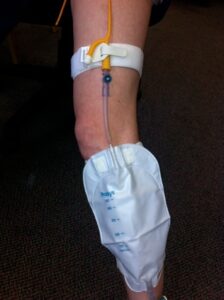
Having a urinary catheter is a helpful treatment for many service users but sometimes problems can occur. Proper care of your catheter will reduce the risk of getting problems. This leaflet discusses how to care for your catheter and what problems may arise.
Reducing the risk of urine infections
Having a catheter increases your risk of getting a urine infection as it is easier for bacteria to enter your bladder.
Catheter infections can be serious and difficult to treat.
Sometimes the infections can be life threatening.
Hand washing and keeping clean helps reduce the risk of getting urine infections.
Hand washing
- You should always wash your hands thoroughly with soap and water before and after dealing with your catheter and drainage bags.
- Carers should always wash their hands thoroughly with soap and water before and after dealing with your catheter and drainage bags and should also wear a new pair of disposable gloves each time.
Keeping clean
- Wash the area where the catheter enters your body every day with mild soap and water.
- Wash the area after you have opened your bowels and if the area gets dirty.
- Avoid using talc or creams.
- Have a daily shower or bath if possible.
- Do not remove your leg bag when you have a shower or bath.
- Dry your leg bag by patting it with a clean towel.
Changing your leg bag correctly
- This will help reduce the risk of urine infections.
- Only change your leg bag every seven days or if it gets dirty or damaged.
- When you change your leg bag, do not touch the tip of the tube (which gets pushed into your catheter).
- Never reuse a leg bag after it has been removed.
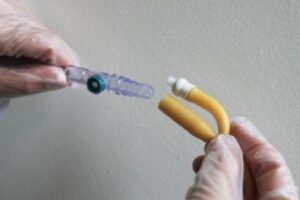
Emptying your leg bag
- Do not let your leg bag get too full and heavy as it will pull and damage your body.
- Empty your bag when it is two thirds full.
- Empty your bag into a clean toilet, jug or urinal.
Connecting your night bag correctly
- This will help reduce the risk of urine infections.
- Use a new night bag every night.
- Connect your night bag to your leg bag.
- Do not touch the tip of the night bag tube (which gets pushed into your leg bag).
Securing and supporting your catheter and drainage bags
-
- This helps reduce the risk of pulling and harm to your body and bladder.
- Secure the catheter to your leg or tummy with a securing device (speak to your nurse if you do not have a securing device).
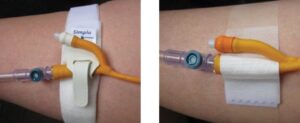
-
- Support your leg bag by either elastic straps or a stretchy sleeve.
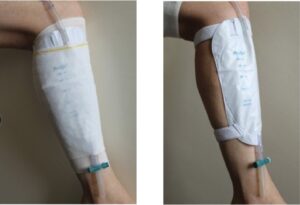
-
- Support your night bag by a floor stand or bed hanger.
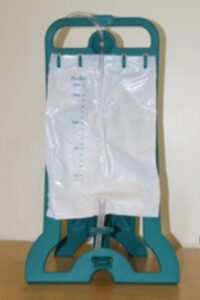
- Never leave your drainage bag touching the floor as it may pick up bacteria.
- Ensure your drainage bags are always positioned below the level of your bladder to help the urine drain.
Fluids
- Drink at least 1 and half to 2 litres (2 and half to 3 and half pints) a day (unless advised otherwise by a healthcare professional).
- This may help reduce the risk of infections.
Bowels
- Eat a healthy diet to avoid constipation as this may cause blocking or leaking of your catheter.
- Speak to your nurse or doctor if you suffer from regular constipation.
Storage of catheters and catheter products
- Store your products in a clean, cool and dry place out of direct sunlight in their original packaging.
- Dispose of products if they are passed their expiry date or if the packaging has been damaged.
Disposal of used catheters and catheter products
- Place used products into two plastic bags before putting them into your household waste bin.
- If you have an infection, ask your nurse for advice as you may need to use a special bin.
- This may help to reduce the risk of spreading infection.
Possible problems: What to do if
Your catheter is not draining
- Check the tubing is not kinked or squashed.
- If possible, try changing your position or walking about.
- Check your drainage bag which may be full and need emptying.
- Check your drainage bag is below the level of your bladder.
- If it is still not draining contact your nurse.
Your catheter is leaking (bypassing) where it enters your body
- Check the tubing is not kinked, pulled or squashed.
- If possible try changing your position or walking about.
- If leaking is an ongoing problem contact your nurse.
Your catheter gets pulled out or falls out
- Contact your nurse.
You may have a urine infection and need to contact your nurse or doctor if you feel unusually unwell and have any of the following:
- a fever;
- pain near your bladder or lower back pain;
- blood in your urine;
- unusual confusion;
- unusual tiredness; or
- feeling like you want to vomit or you are vomiting.
Contact your nurse
To discuss if it is possible to:
- try without your catheter
- use a catheter valve (a discreet product to use instead of a leg bag)
Do intermittent catheterisation (use a removable catheter to periodically drain urine from your bladder, this may have less risk of urine infections).
Patient information
Urinary catheter securing device fact sheet (for care providers)
Urinary catheter securing device fact sheet (for care providers)
What is a catheter securing device?
A catheter securing device is a product that is used to secure an indwelling urinary catheter.
Why use a securing device?
The securing device may help reduce the risk of problems that can be caused by an unsecured catheter. These problems include:
- Pain
- Bleeding
- Swelling, ulcers or tearing to the urethra
- Damage to the genitals or bladder neck
- Catheter falling out
- Leaking or blocking of the catheter
- Frequent catheter changes
- Urine infections
Should leg bag straps or leg bag sleeves still be used when using a securing device?
- Yes they should still be used.
- Leg bag straps and stretchy sleeves are used to support the weight of the leg bag.
- If leg bag straps or stretchy sleeves are not used
then the catheter is very likely to damage the
body. - The catheter is also very likely to be pulled out.
Which devices are often used?
The Coloplast G Strap
This is an elastic strap which is attached around the leg or waist.

Clinifix® universal tube fixation device
This is attached by adhesive. Clinifix® is distributed by CliniMed Limited

The Statlock® Foley stabilisation device
This is attached by adhesive.

Please see separate instruction sheets provided for each device.
When should the strap type device NOT be used?
If the service user has circulation problems and
the strap device may make this worse.
When should the adhesive device NOT be used?
- If the service user has fragile skin (as the device may tear or damage the skin)
- If the service user has an allergy to the adhesive (as it may cause a rash)
When else could the device cause harm?
- If the catheter is placed in the device so it is stretched. A stretched catheter will pull on the urethra and bladder and may cause damage. The catheter may also be pulled out.
- If the service user lies or leans on the device. This may cause pressure damage to the skin.
When should I contact the patient’s nurse?
- If the patient is not using a securing device
- If you think the device is causing problems, pain or harm to the patient
- If the device is not properly securing the catheter


